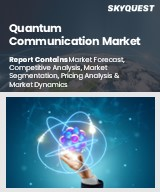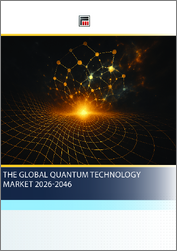
|
시장보고서
상품코드
1764761
양자 통신 시장(2025-2032년) : 제공 서비스별, 전송 매체별, 전개 모드별, 조직 규모별, 업종별, 지역별 규모, 점유율 및 성장 분석과 산업 예측Quantum Communication Market Size, Share, and Growth Analysis, By Offering, By Transmission Medium, By Deployment Mode, By Organization Size, By Vertical, By Region - Industry Forecast 2025-2032 |
||||||
양자 통신 세계 시장 규모는 2023년 12억 달러로 평가되었고, 2024년 15억 7,000만 달러에서 2032년에는 138억 2,000만 달러로 성장할 전망이며 예측기간(2025-2032년)의 CAGR은 31.2%로 예상됩니다.
세계 양자 통신 시장은 주로 사이버 보안 위협 증가와 첨단 양자 컴퓨팅과 관련된 임박한 리스크로 인해 큰 성장을 이루고 있습니다. 향후 해독할 수 있는 '지금 수집, 나중에 해독' 공격에 대항하는 솔루션의 도입이 시급해지고 있으며 이는 양자 통신에 대한 큰 투자로 이어지고 있습니다. 주목할 만한 동향은 연구실의 프로토타입으로부터 상업적으로 실현 가능한 실리콘 포토닉 QKD 모듈로의 전환이며 이는 비용 효율적인 확장성을 촉진하고 있습니다. 양자 통신 기술과 기술 벤더 및 학술기관의 콜라보레이션의 활성화에 의해 표준화 수립이 추진되고 있으며 이는 다양한 분야에서의 차세대 네트워크 시큐리티에 있어서 양자 통신이 극히 중요한 역할을 담당하고 있음을 강조되고 있습니다.
목차
소개
- 조사 목적
- 조사 범위
- 정의
조사 방법
- 정보 수집
- 2차 및 1차 데이터 방법
- 시장 규모 예측
- 시장의 전제조건과 제한
주요 요약
- 세계 시장 전망
- 공급과 수요 동향 분석
- 부문별 기회 분석
시장 역학과 전망
- 시장 개요
- 시장 규모
- 시장 역학
- 성장 촉진요인과 기회
- 억제요인과 과제
- Porter's Five Forces 분석
주요 시장 인사이트
- 주요 성공요인
- 경쟁도
- 주요 투자 기회
- 시장 생태계
- 시장의 매력 지수(2024년)
- PESTEL 분석
- 거시경제지표
- 밸류체인 분석
- 가격 분석
- 사례 연구
- 기술 분석
양자 통신 시장 규모 : 제공 서비스별&CAGR(2025-2032년)
- 시장 개요
- 솔루션
- 양자 통신 컴포넌트
- 양자 메모리
- 광자원
- 양자 검출기
- 양자 변조기와 송수신기
- 양자 중계기
- 양자 키 분배(QKD) 솔루션
- 양자 난수 생성기(QRNG)
- 하드웨어 기반 QRNG
- 소프트웨어 기반 QRNG
- 양자내성암호 솔루션
- 서비스
- 전문 서비스
- 교육 및 컨설팅
- 전개 및 통합
- 지원 및 유지 보수
- 매니지드 서비스
양자 통신 시장 규모 : 전송 매체별&CAGR(2025-2032년)
- 시장 개요
- 섬유 기반 QKD
- 자유 공간/위성 기반 QKD
양자 통신 시장 규모 : 전개 모드별 &CAGR(2025-2032년)
- 시장 개요
- On-Premise
- 클라우드
양자 통신시장 규모 : 조직 규모별&CAGR(2025-2032년)
- 시장 개요
- 중소기업
- 대기업
양자 통신 시장 규모 : 업계별&CAGR(2025-2032년)
- 시장 개요
- BFSI
- 정부 및 방위
- 헬스케어
- 항공 우주
- IT 및 통신
- 에너지 및 유틸리티
- 학술 연구
- 기타 업종
양자 통신 시장 규모&CAGR(2025-2032년)
- 북미
- 미국
- 캐나다
- 유럽
- 독일
- 스페인
- 프랑스
- 영국
- 이탈리아
- 기타 유럽
- 아시아태평양
- 중국
- 인도
- 일본
- 한국
- 기타 아시아태평양
- 라틴아메리카
- 브라질
- 기타 라틴아메리카
- 중동 및 아프리카
- GCC 국가
- 남아프리카
- 기타 중동 및 아프리카
경쟁 정보
- 상위 5개사 비교
- 주요 기업의 시장 포지셔닝(2024년)
- 주요 시장 기업이 채용한 전략
- 최근 시장 동향
- 기업의 시장 점유율 분석(2024년)
- 주요 기업의 기업 프로파일
- 기업의 상세
- 제품 포트폴리오 분석
- 기업의 부문별 점유율 분석
- 전년 대비 수익 비교(2022-2024년)
주요 기업 프로파일
- Toshiba
- Thales
- Quintessencelabs
- Quantumctek
- Magiq Technologies
- Crypta Labs
- Quantum Xchange
- Qeynet
- Qulabs
- Quantropi
- QTI SRL
- NodeQ
- Thinkquantum
- Arqit
- Aliro Quantum
- Nucrypt
- Ki3 Photonics
- Miraex
- S-Fifteen Instruments
- Heqa Security(Formerly Quantrl)
결론과 권고
CSM 25.07.15Global Quantum Communication Market size was valued at USD 1.2 billion in 2023 and is poised to grow from USD 1.57 billion in 2024 to USD 13.82 billion by 2032, growing at a CAGR of 31.2% during the forecast period (2025-2032).
The global quantum communication market is experiencing significant growth, primarily fueled by increasing cybersecurity threats and the imminent risks associated with advanced quantum computing. Various sectors, including finance, healthcare, defense, and government, are urgently implementing solutions to combat "harvest now, decrypt later" attacks, which involve the interception and storage of encrypted data for future decryption. This situation has led to substantial investments in quantum-safe technologies, especially in Quantum Key Distribution (QKD) devices and next-generation transceivers that enhance critical data infrastructure security. A notable trend is the transition from laboratory prototypes to commercially viable silicon-photonic QKD modules, promoting cost-effective scalability. Additionally, hybrid network architectures and increased collaboration among technology vendors and academic institutions are driving standardization efforts, emphasizing quantum communication's pivotal role in next-generation network security across diverse sectors.
Top-down and bottom-up approaches were used to estimate and validate the size of the Global Quantum Communication market and to estimate the size of various other dependent submarkets. The research methodology used to estimate the market size includes the following details: The key players in the market were identified through secondary research, and their market shares in the respective regions were determined through primary and secondary research. This entire procedure includes the study of the annual and financial reports of the top market players and extensive interviews for key insights from industry leaders such as CEOs, VPs, directors, and marketing executives. All percentage shares split, and breakdowns were determined using secondary sources and verified through Primary sources. All possible parameters that affect the markets covered in this research study have been accounted for, viewed in extensive detail, verified through primary research, and analyzed to get the final quantitative and qualitative data.
Global Quantum Communication Market Segments Analysis
Global Quantum Communication Market is segmented by Offering, Transmission Medium, Deployment Mode, Organization Size, Vertical and region. Based on Offering, the market is segmented into Solutions and Services. Based on Transmission Medium, the market is segmented into Fiber-Based QKD and Free-Space/Satellite-Based QKD. Based on Deployment Mode, the market is segmented into On-Premises and Cloud. Based on Organization Size, the market is segmented into SMEs and Large Enterprises. Based on Vertical, the market is segmented into BFSI, Government & Defense, Healthcare, Aerospace, IT & Telecommunications, Energy & Utilities, Academia & Research and Other Verticals. Based on region, the market is segmented into North America, Europe, Asia Pacific, Latin America and Middle East & Africa.
Driver of the Global Quantum Communication Market
The rapid evolution of cyber threats and the potential of quantum computers to break traditional encryption techniques have created an urgent need for quantum-safe communication solutions, driving significant growth in the global quantum communication market. Organizations that handle sensitive data, such as financial institutions, defense agencies, and healthcare providers, are increasingly pressured to safeguard their information against future decryption threats, often referred to as "store now, decrypt later" attacks. Consequently, these entities are compelled to invest in quantum key distribution systems and necessary hardware. This proactive approach ensures that even if encrypted communications are intercepted today, they will remain secure against the advanced decryption capabilities of tomorrow.
Restraints in the Global Quantum Communication Market
The Global Quantum Communication market faces significant restraints due to the high costs associated with developing reliable end-to-end solutions, which necessitate specialized hardware such as single-photon detectors and entangled photon sources. These expenses extend beyond initial purchases, as the technology demands controlled environments, expert installation, and ongoing maintenance from trained professionals. For many potential customers, especially those in mid-market sectors and emerging economies, these capital and operational challenges create hesitance in adopting quantum communication solutions. The barriers to market entry and resulting delays in commercial deployment raise concerns for major clients focused on enhancing their security measures.
Market Trends of the Global Quantum Communication Market
The Global Quantum Communication market is witnessing a pivotal trend toward harmonized deployment alongside legacy infrastructure, characterized by the integration of quantum communication technologies with existing systems. Leading vendors are innovating solutions that enable Quantum Key Distribution (QKD) signals to coexist with high-speed classical data streams on the same optical fibers, leveraging Dense Wavelength Division Multiplexing (DWDM) and advanced filtering techniques. This approach not only facilitates secure quantum key generation and distribution without disrupting legacy traffic but also significantly reduces deployment barriers. By optimizing existing network equipment, it lowers capital and operational costs, accelerating adoption among enterprises and telecommunications providers in metropolitan and long-haul environments, thus propelling the market's growth.
Table of Contents
Introduction
- Objectives of the Study
- Scope of the Report
- Definitions
Research Methodology
- Information Procurement
- Secondary & Primary Data Methods
- Market Size Estimation
- Market Assumptions & Limitations
Executive Summary
- Global Market Outlook
- Supply & Demand Trend Analysis
- Segmental Opportunity Analysis
Market Dynamics & Outlook
- Market Overview
- Market Size
- Market Dynamics
- Drivers & Opportunities
- Restraints & Challenges
- Porters Analysis
- Competitive rivalry
- Threat of substitute
- Bargaining power of buyers
- Threat of new entrants
- Bargaining power of suppliers
Key Market Insights
- Key Success Factors
- Degree of Competition
- Top Investment Pockets
- Market Ecosystem
- Market Attractiveness Index, 2024
- PESTEL Analysis
- Macro-Economic Indicators
- Value Chain Analysis
- Pricing Analysis
- Case Studies
- Technology Analysis
Global Quantum Communication Market Size by Offering & CAGR (2025-2032)
- Market Overview
- Solutions
- Quantum Communication Components
- Quantum memory
- Photon sources
- Quantum detectors
- Quantum modulators & transceivers
- Quantum repeaters
- Quantum Key Distribution (QKD) Solutions
- Quantum Random Number Generator (QRNG)
- Hardware-based QRNG
- Software-based QRNG
- Quantum-Safe Cryptographic Solutions
- Services
- Professional Services
- Training & Consulting
- Deployment & Integration
- Support & Maintenance
- Managed Services
Global Quantum Communication Market Size by Transmission Medium & CAGR (2025-2032)
- Market Overview
- Fiber-Based QKD
- Free-Space/Satellite-Based QKD
Global Quantum Communication Market Size by Deployment Mode & CAGR (2025-2032)
- Market Overview
- On-Premises
- Cloud
Global Quantum Communication Market Size by Organization Size & CAGR (2025-2032)
- Market Overview
- SMEs
- Large Enterprises
Global Quantum Communication Market Size by Vertical & CAGR (2025-2032)
- Market Overview
- BFSI
- Government & Defense
- Healthcare
- Aerospace
- IT & Telecommunications
- Energy & Utilities
- Academia & Research
- Other Verticals
Global Quantum Communication Market Size & CAGR (2025-2032)
- North America (Offering, Transmission Medium, Deployment Mode, Organization Size, Vertical)
- US
- Canada
- Europe (Offering, Transmission Medium, Deployment Mode, Organization Size, Vertical)
- Germany
- Spain
- France
- UK
- Italy
- Rest of Europe
- Asia Pacific (Offering, Transmission Medium, Deployment Mode, Organization Size, Vertical)
- China
- India
- Japan
- South Korea
- Rest of Asia-Pacific
- Latin America (Offering, Transmission Medium, Deployment Mode, Organization Size, Vertical)
- Brazil
- Rest of Latin America
- Middle East & Africa (Offering, Transmission Medium, Deployment Mode, Organization Size, Vertical)
- GCC Countries
- South Africa
- Rest of Middle East & Africa
Competitive Intelligence
- Top 5 Player Comparison
- Market Positioning of Key Players, 2024
- Strategies Adopted by Key Market Players
- Recent Developments in the Market
- Company Market Share Analysis, 2024
- Company Profiles of All Key Players
- Company Details
- Product Portfolio Analysis
- Company's Segmental Share Analysis
- Revenue Y-O-Y Comparison (2022-2024)
Key Company Profiles
- Toshiba
- Company Overview
- Business Segment Overview
- Financial Updates
- Key Developments
- Thales
- Company Overview
- Business Segment Overview
- Financial Updates
- Key Developments
- Quintessencelabs
- Company Overview
- Business Segment Overview
- Financial Updates
- Key Developments
- Quantumctek
- Company Overview
- Business Segment Overview
- Financial Updates
- Key Developments
- Magiq Technologies
- Company Overview
- Business Segment Overview
- Financial Updates
- Key Developments
- Crypta Labs
- Company Overview
- Business Segment Overview
- Financial Updates
- Key Developments
- Quantum Xchange
- Company Overview
- Business Segment Overview
- Financial Updates
- Key Developments
- Qeynet
- Company Overview
- Business Segment Overview
- Financial Updates
- Key Developments
- Qulabs
- Company Overview
- Business Segment Overview
- Financial Updates
- Key Developments
- Quantropi
- Company Overview
- Business Segment Overview
- Financial Updates
- Key Developments
- QTI S.R.L.
- Company Overview
- Business Segment Overview
- Financial Updates
- Key Developments
- NodeQ
- Company Overview
- Business Segment Overview
- Financial Updates
- Key Developments
- Thinkquantum
- Company Overview
- Business Segment Overview
- Financial Updates
- Key Developments
- Arqit
- Company Overview
- Business Segment Overview
- Financial Updates
- Key Developments
- Aliro Quantum
- Company Overview
- Business Segment Overview
- Financial Updates
- Key Developments
- Nucrypt
- Company Overview
- Business Segment Overview
- Financial Updates
- Key Developments
- Ki3 Photonics
- Company Overview
- Business Segment Overview
- Financial Updates
- Key Developments
- Miraex
- Company Overview
- Business Segment Overview
- Financial Updates
- Key Developments
- S-Fifteen Instruments
- Company Overview
- Business Segment Overview
- Financial Updates
- Key Developments
- Heqa Security (Formerly Quantrl)
- Company Overview
- Business Segment Overview
- Financial Updates
- Key Developments



















